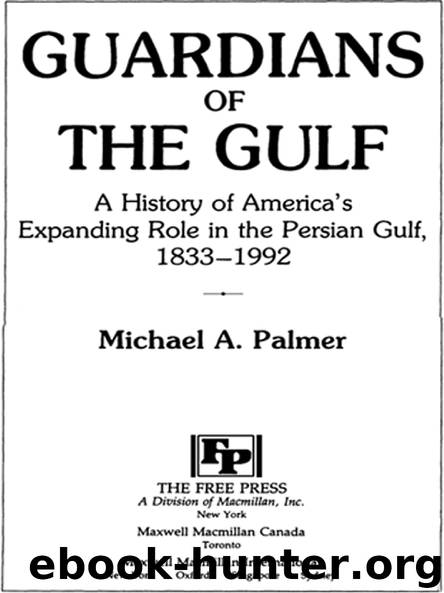GUARDIANS OF THE GULF by Michael A. Palmer

Author:Michael A. Palmer
Language: eng
Format: epub
Publisher: SIMON & SCHUSTER
Published: 1992-07-15T00:00:00+00:00
If Saddam did send his army south, American military options were limited. A naval blockade of Iraq and occupied Kuwait was unlikely to force Saddam to withdraw and would do virtually nothing to impede an Iraqi drive further south. The carriers Independence and Eisenhower could launch airstrikes against targets in Iraq or against forces advancing into Saudi Arabia. But aircraft flying from carriers in the North Arabian and Red Seas would be operating at extreme range and would be heavily outnumbered by Saddam’s 800-plane air force. The best way to deter an Iraqi strike south, stop that attack should it materialize, and build up a force capable of forcing Saddam to withdraw from Kuwait was to move U.S. ground and air units into Saudi Arabia. But even with full Saudi cooperation, General Schwarzkopf warned the president that it would take seventeen weeks to deploy USCENTCOM’s forces—about 225,000 personnel—to the gulf, and eight to twelve months to build up a force capable of driving the Iraqis from Kuwait. 8
Following the Camp David meeting, President Bush telephoned King Fahd for the second time since August 2. Other American officials conferred with Prince Bandar bin Sultan—the Saudi ambassador to the United States and the king’s nephew. These consultations led to a decision on August 5 to send a high-level American delegation headed by Secretary of Defense Cheney and General Schwarzkopf to Jidda to meet with King Fahd.
In the interim, the situation along the Saudi border became more threatening and the crisis atmosphere in the gulf continued to build. Three times between August 3 and 6 Iraqi forces crossed into Saudi Arabia, further heightening Saudi fears. 9 The Arab talks scheduled for August 4 in Jidda collapsed.
Focus shifted to the battle over the Turkish and Saudi pipelines that carried 90 percent of Iraq’s exported oil. If economic sanctions against Saddam were to be effective, the pipelines had to be shut down. On August 3 the United States had requested that both Turkey and Saudi Arabia stop the flow of oil. Turkey, a populous nation with defensible borders, a large military establishment, and membership in NATO was relatively secure from Saddam’s threats. But Saudi Arabia, sparsely populated, with indefensible borders, a small military establishment, and no formal security ties, was not. On August 5, the Iraqis warned the Turks about the possible consequences if they shut down their pipeline. 10 As the pressure against Saudi Arabia increased, a key aspect of Cheney’s mission became to convince the Saudis to halt the flow of Iraq oil, in return for American protection. 11
Concerns about the safety of foreigners in Kuwait also mounted as reports of the roundup of Westerners reached Washington. 12 The new Kuwaiti government did little to assuage Western fears, warning that it would not necessarily “act honorably” toward foreign citizens. 13 Bush, returning to Washington on Sunday, told the press that the the Iraqi invasion “will not stand,” and when asked what the United States could do to reverse it, remarked: “Just wait, watch and learn.
Download
This site does not store any files on its server. We only index and link to content provided by other sites. Please contact the content providers to delete copyright contents if any and email us, we'll remove relevant links or contents immediately.
| Arms Control | Diplomacy |
| Security | Trades & Tariffs |
| Treaties | African |
| Asian | Australian & Oceanian |
| Canadian | Caribbean & Latin American |
| European | Middle Eastern |
| Russian & Former Soviet Union |
The Secret History by Donna Tartt(18764)
The Social Justice Warrior Handbook by Lisa De Pasquale(12087)
Thirteen Reasons Why by Jay Asher(8744)
This Is How You Lose Her by Junot Diaz(6708)
Weapons of Math Destruction by Cathy O'Neil(6090)
Zero to One by Peter Thiel(5643)
Beartown by Fredrik Backman(5554)
The Myth of the Strong Leader by Archie Brown(5380)
The Fire Next Time by James Baldwin(5205)
How Democracies Die by Steven Levitsky & Daniel Ziblatt(5101)
Promise Me, Dad by Joe Biden(5041)
Stone's Rules by Roger Stone(4994)
100 Deadly Skills by Clint Emerson(4803)
A Higher Loyalty: Truth, Lies, and Leadership by James Comey(4803)
Rise and Kill First by Ronen Bergman(4663)
Secrecy World by Jake Bernstein(4599)
The David Icke Guide to the Global Conspiracy (and how to end it) by David Icke(4563)
The Farm by Tom Rob Smith(4409)
The Doomsday Machine by Daniel Ellsberg(4380)
